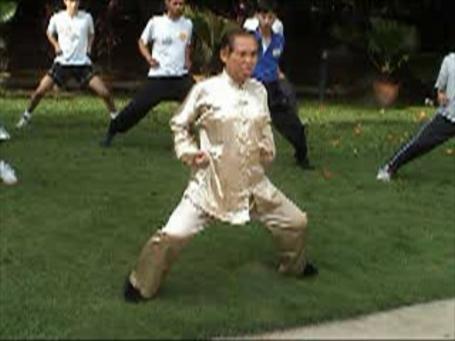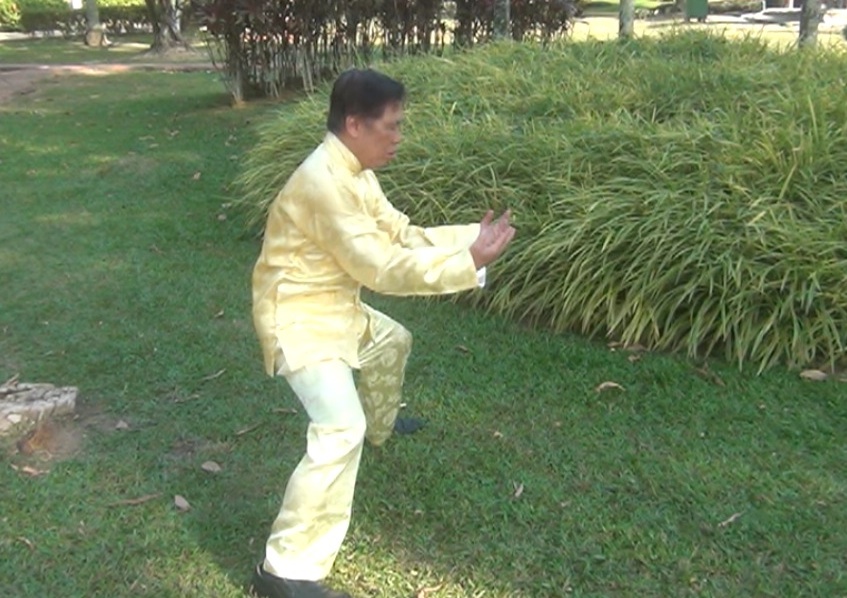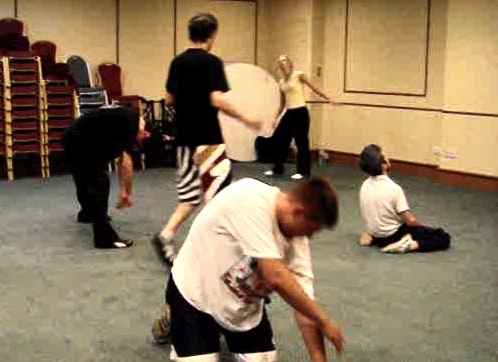SELECTION OF QUESTIONS AND ANSWERS
DECEMBER 2014 PART 3

Lifting Water
Question 1
What are the best fundamental flowing force and consolidating force methods to teach beginners?
— Sifu Barry, UK.
Answer
Cloud Hands and Lifting Water (from 108-Pattern Yang Style Set) are excellent methods to teach flowing force, and Single Dragon Emerges from Sea (from Triple Stretch) and Double Dragons Emerge from Sea (from Dragon-Tiger) are excellent for teaching consolidating force to both beginners and advanced practitioners.
Question 2
On the Art of Teaching course you said that the benefits of chi kung came from form (10%), energy (30%) and mind (60%).
Is this also true for internal force training?
What does that mean about how much time I should spend on them getting the form correct versus "enjoying themselves" with a technique like Cloud Hands?
Is the balance different for flowing and consolidating force methods?
Answer
Yes, the same proportion applies to force training too. The time spent is the same.
For example, if we spent 5 minutes, or any length of time, on Cloud Hands, but focus on form only without focusing on chi flow or mind, we get 100 units of internal force. If we focus on chi flow, we get 300 units of internal force. If we focus on mind, we get 600 units of internal force. If we focus on all the three aspects, we get 1000 units of internal force.
The proportion, or balance, is the same for flowing force and consolidating force.
Horse-Riding Stance
Question 3
Is it important to include a static force training method for beginners?
Answer
It is not necessary but important to include static force training for both beginners and advanced students if they practice kungfu. If they do not practice kungfu, it is not important but helpful to speed up their force development if practiced correctly.
Examples of static force training are the stances, like the Horse-Riding Stance and the Three-Circle Stance. Examples of flowing force training is practicing any dynamic chi kung exercise, like Lifting the Sky and Cloud Hands.
Static force training increases internal force rapidly. It is for this reason that all kungfu training, including Taijiquan and Baguazhang, starts with stances. But modern kungfu practitioners do away with stance training. They probably do not realize this fact.
If it is not necessary to develop much internal force, flowing force training can replace static force training. This is the reason why chi kung practitioners need not practice stances.
It is important to practice static force training correctly. Of course, it is necessary to practice all exercises correctly, but the need is more urgent in static force training because failure to do so would bring more harmful effect and also more quickly than in flowing force training.
Question 4
Is there a difference between developing flowing and consolidated force and building internal force?
Answer
Both developing flowing force and developing consolidated force build internal force. There is a difference in the methods of building internal force:
- Using only flowing force to build internal force.
- Using only consolidating force to build internal force.
- Using both flowing force and consolidating force to build internal force.
There is also some difference when we vary the proportion of flowing force and consolidating force when using both flowing force and consolidating force in building internal force. For example, there is a difference between the internal force of the Flower Set where there is more flow than consolidating, and the internal force of Triple Stretch where there is more consolidating than flow.
Yes, there is a difference between developing flowing force and developing consolidated force. When developing flowing force, the method involves movement, like Pushing Mountains and Grasping Sparrow's Tail. When developing consolidated force, the method involves static posture, like Golden Bridge and Cosmos Stance.
Relatively, practicing flowing force is more relaxing and the risk of harmful side-effects is less. Practicing consolidated force is relatively more demanding and the risk of harmful side effects is more. The force developed in consolidated force is generally stronger, but it is more localized, whereas that of flowing force is less but more spread out.
Force training methods like One-Finger Shooting Zen and Double Dragons Emerge from Sea are both flowing and consolidated. The proportion may vary, but generally that in One-Finger Shooting Zen is 60% flowing and 40% consolidated, and that in Double Dragons Emerge from Sea is 40% flowing and 60% consolidated.
In Yang Style Taijiquan it is 100% flowing, and in Horse-Riding Stance it is 100% consolidated. Although Iron Wire uses movement, the force is also 100% consolidated in the orthodox method. The movement is physical and not flowing energy. However, because we know chi flow, we are able to perform Iron Wire with some flowing force.

Dragon Strength
Question 5
I noticed in the Dragon Strength Set, in the force building section there, it appears you have a slightly rounded back. I wanted to ask three questions:
- Am I seeing that correctly?
- What is the significance of the rounded back?
- Are there any sections of Force Building in the Taming Tiger set where this is also true?
Answer
Yes, your seeing my slightly rounded back was correct. It was spontaneous.
The rounding of my back facilitated better flow of chi.
The rounding of the back is spontaneous. It occurs as a result of powerful chi flow. There are no specific sections in the Taming Tiger Set, or any set, to purposely round the back.
Nevertheless, the rounding of the back may occur more readily in some patterns than in others. For example, at the start of the set after the greeting, when a practitioner lowers his two taming-hands while on a Horse-riding Stance, his back may be rounded due to strong chi flow from his back to his palms.
Question 6
Over the past few days, I did not feel much third eye activity after practice. All of a sudden between yesterday and today, there has been slight pain and consistent pressure in the middle of my forehead. In fact, it has been so persistent throughout the day that I feel somewhat nauseous at work.
I have been trying to focus at my dan tian but that seems to make the third eye pressure worse.
Does Sigung have any advice to deal with this temporary discomfort?
— Stephen, USA
Answer
Congratulations, it is an indication that your third eye is opening. Yours are characteristics of the opening of the third eye.
If the pain is tolerable, let it be. It is a little price to pay. If it is very painful, enjoy a gentle chi flow.
What is most important is that you must never abuse the amazing benefits of the third eye.

Chi flow after some kungfu performance
Question 7
Sifu, have you ever heard of Hao Tang Lang Quan? It is a style of Kung Fu which I found here but I don't know if it is a good style and I haven't met the teacher yet.
— John, Korea
Answer
The Hao Tang Lang Quan you referred to is Hao Family Praying Mantis Kungfu, founded by Hao Lian Nu who combined his original Lohan Kungfu and Monkey Style with Taiji Praying Mantis Kungfu and Plum Flower Praying Mantis Kungfu. It is a good style.
But the more important factor is whether the teacher is competent. If the teacher is competent, it is recommended you join the school. If the teacher is incompetent, you should avoid it even when the style is good.
It is better to learn from a good teacher of a mediocre style than a bad teacher of a good style. A good teacher is one who will help you to get the benefits of what your practice is meant to bring, whereas a bad teacher is one who causes harmful effects even when the style he teaches should bring benefits.
Question 8
Why is there more chi flow developed in kungfu training than in chi kung training?
— Juan, Spain
Answer
It is because more energy is generated in kungfu training than in chi kung training.
The chi flow movements in our kungfu classes are vigorous, sometimes hilarious. An uninitiated observer could be excused if he thought he had entered a zoo when he came into our kungfu class.
On the other hand, if they want to, our kungfu practitioners can control their chi flow movements and remain quite still though they have generated a lot of energy. Generally, our kungfu practitioners have better control over chi flow than our chi kung practitioners.
Another reason why our kungfu practitioners have more vigorous chi flow movements than our chi kung practitioners is that the former are free from inhibition, whereas the latter, especially beginners, are inhibited and therefore do not let themselves go freely.
It is worthy of note that in our school, kungfu is chi kung. In other words when our Shaolin or Taijiquan practitioners perform their kungfu sets, combat sequences, force training or engage in free sparring, they train energy and experience chi flow. Nevertheless, here we use the terms "kungfu" and "chi lung" as what the general public conceptualize the terms to be. Hence, in this context, chi kung training refers to practitioners performing exercises like Eighteen Jewels, Eighteen Lohan Hands, and Bone Marrow Cleansing.
LINKS
Selected Reading
- Various Types of Internal Force
- Is the Five-Animal Play Related to Chi Flow?
- Conditional Free Sparring
- Converting Flow into Force in the Flow Method
- The Three Internal Harmonies of Essence, Energy and Mind
